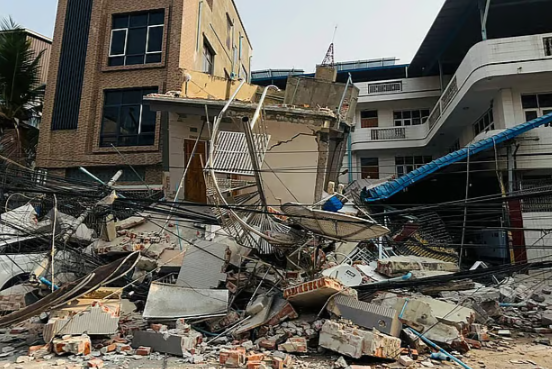Prothom Alo
If we observe the 2023 Turkey earthquake (magnitude 7.8), we will see almost 53,500 people were killed during that earthquake through building collapse. Again, if we go back to 2010 Haiti (magnitude 7.0) and 2010 Chile earthquakes (magnitude 8.8) we will see that almost 230,000 people of Haiti were killed by poorly constructed buildings in Haiti, but only 280 people were killed in Chile, although the energy released by the Chile earthquake was 800 times more than the Haiti earthquake.
Bangladesh may expect a 7.5 magnitude earthquake any time in near future.
Following are important issues we need to consider immediately to reduce the effect of a possible earthquake in Bangladesh:
1. Assessment of existing buildings of our cities, marking the weak (RED), moderately weak (YELLOW) and relatively strong buildings (GREEN) to withstand earthquakes. This will allow our central and city-level authorities to prioritise which buildings need immediate retrofitting and allow the banks based on proper documentation to loan funding to the building owner for those retrofitting works. This process has been followed to retrofit almost 500 garments industry buildings in Bangladesh for the last 10 years under the labour ministry.
2. This retrofitting work needs monitoring and supervision by a third-party engineering firm in various stages of the retrofitting work. Currently, Bangladesh may have around 100 engineering consultancy firms who are capable of undertaking this type of work. This number needs to be increased significantly through proper mentoring and training.
3. Another priority is to train fresh graduate engineers regarding earthquake resistance design issues of both buildings as well as the ground (soil) on which it will rest. A three-month short course may be offered by a pool of competent engineers or professors who have prior knowledge of these issues under the umbrella of a licensing agency, headed by a professional engineer of adequate experience.
4. Most of the structural designs/drawings of new buildings in Bangladesh are based on BNBC/Code. The main problem is the implementation of the structural drawings according to the structural designs/drawings and quality control of materials (cement, rods, etc.) during the new construction. For this purpose again a qualified and trained third party engineering firm may be employed. Based on their report and recommendation, CDA, KDA, RDA, RAJUK, and other city corporations will allow owner of the building to occupy the building, through an occupancy certificate. Our building construction code has provisions for such certificates.
5. Also we need to solve the issue of duality of the role of CDA/KDA/RAJUK, City Corporations and Fire Service Department in Bangladesh. In California and NY (USA), Tokyo (Japan), Calcutta and Mumbai (India), Manila (The Philippines), Istanbul (Turkey), all these agencies work under the direct supervision of a mayor. In pre-disaster, disaster and post-disaster phases, a single authority guides those agencies. In our cities, the issue has become complex, due to the presence of three or more agencies meddling in each other’s work. We need to resolve this issue immediately.
6. Risk-sensitive land use planning maps (based on site amplification, liquefaction, etc.) for large and small cities need to be developed, so that engineers can decide whether investment on ground/soil improvement is needed or not for a particular construction project based on this map.
7. Lifeline systems (like electricity, gas, mobile phone networks, telecommunications, transportation, and water supply systems) need to be made earthquake resistant based on the above risk-sensitive maps and building code. Also emergency shut-down protocol needs to be established for these systems to reduce the secondary disasters such as fire hazards.
8. Urban volunteer auxiliary forces need to be formed and maintained by the fire service department. A law also needs to be enacted to use this force during any urban disaster similar to the CPP volunteer in the coastal area. This auxiliary force, who will be picked from the local community people need to be trained for search and rescue purposes and some small tools for that purposes need to be kept at the local fire service offices.
9. City Corporation level Emergency Operation Centers (EoC) need to be established and manned by competent officers. Proper protocol is needed to run these EoCs.
If we can follow the above suggestions, the damages due to an earthquake can hopefully be minimised significantly. Many of the above issues have been conveyed to the government over the last couple of years but without any visible undertakings by the authorities. The 7.7 magnitude Myanmar earthquake should be our final warning signal or wake up call.
* Prof. Mehedi Ahmed Ansary, BUET, Founder Director BUET-Japan Institute of Disaster Prevention & Urban Safety (BUET-JIDPUS) and Founder Secretary General, Bangladesh Earthquake Society (BES)

